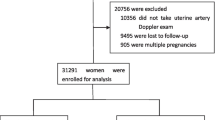Abstract
Objective
To find out whether placental laterality and abnormal uterine artery waveform and resistance index, as determined by antenatal ultrasonography and Doppler, can be used as a predictor for the development of preeclampsia.
Methods
This prospective observational cohort study was conducted from August 2013 to October 2014. Two hundred and one (201) normotensive, primigravida women with singleton pregnancies attending the antenatal clinics without any high-risk factor for development of hypertension were subjected to ultrasonography at 18–22 weeks of gestation to determine the placenta location. All the subjects with lateral placentas were subjected to Doppler ultrasonography to look for abnormal Doppler waveform and resistance index. They were followed for the development of preeclampsia till 40 weeks of gestation or delivery.
Result
Out of the total 201 women, 71 (24.5 %) had laterally located placentas and of them 37 (52 %) developed preeclampsia, while the remaining 130 (75.5 %) had centrally located placentas and of them 14 (10.8 %) developed preeclampsia (p < 0.001). In subjects with lateral placentas alone (n = 33), 2 (6 %) developed preeclampsia while as those with lateral placentas with Doppler abnormality (n = 38), 35 (92 %) developed preeclampsia (p < 0.001). The overall risk of developing preeclampsia with laterally located placenta was 9.27 (odds ratio), and 95 % confidence interval was (4.30–19.98).
Conclusion
Pregnant women with lateral placentas are at significant risk for development of preeclampsia. Lateral placentas when associated with uterine artery Doppler abnormality, risk for development of preeclampsia increases significantly as compared to lateral placentas alone.
Similar content being viewed by others

References
Cunningham FG, Veno KJ, Bloom SL. Pregnancy hypertension. In: Williams Obstetrics. 23 edn. New York: McGraw-Hill Medical; 2010.
Sober S, Reiman M, Kika T, Rull K, Inno R, Vaas P, et al. Extensive shift in placental transcriptome profile in preeclampsia and placental origin of adverse pregnancy outcomes. Sci Rep. 2015; doi:10.1038/srep13336.
Patel A, Dabhadkar S, Taralekar V. Placental laterality and uterine artery resistance for prediction of preeclampsia. Indian J Appl Res. 2012;2:118–9.
Mose JC. The role of maternal and fetal Doppler in pre-eclampsia. Pregnancy Hypertens. 2014;4:224–30.
Kakker T, Singh V, Razdan R. Placental laterality as a predictor for development of preeclampsia. JOGI. 2013;63:22–5.
Fung TY, Sahota DS, Lau TK, Leung TY, Chan LW, Chung TK. Placental site in the second trimester of pregnancy and its association with subsequent obstetric outcome. Am J Pathol. 2015;185:2731–41.
Seckin KD, Cakmak B, Karsli MF, Yeral MI, Gultekin IB, Oz MD, et al. Is lateral localization of placenta a risk factor for adverse perinatal outcomes? Reprod Sci. 2015;22:316–21.
Jani PS, Patel UM, Ghandi MR, Thakor NC, Kakani CR. Placental laterality and uterine artery resistance as predictor of preeclampsia. Int J Res Med Sci. 2015;3:1484–7.
Nagar T, Sharma D, Choudhary M, Khoiwal S, Nagar RP, Pandita A. The role of uterine and umbilical arterial Doppler in high-risk pregnancy. A prospective observational study from India. Clin Med Insights Reprod Health. 2015;9:1–5.
Pagani G, Gerosa V, Gregorini ME, Rovida PL, Prefumo F, Valcamonico A, et al. The role of Doppler to predict adverse pregnancy outcome in patients with pre-eclampsia. Hypertension. 2013;62:1046–54.
Ventura W, De Paco Matallana C, Prieto-Sanchez MT, Macizo MI, Pertegal M, Nieto A, et al. Uterine and umbilical artery Doppler at 28 weeks for predicting adverse pregnancy outcomes in women with abnormal uterine artery Doppler findings in the early second trimester. Pregnancy Hypertens. 2012;2:298–9.
Ohkuchi A, Hirashima C, Takahashi K, Shirasuna K, Suzuki H, Ariga H, et al. A trio of risk factors for the onset of preeclampsia in the second and early third trimesters. Clin Med Insights Reprod Health. 2015;9:1–5.
Roeder HA, Dejbakhsh SZ, Parast MM, Laurent LC, Woelkers DA. Abnormal uterine artery Doppler velocimeter predicts adverse outcomes in patients with abnormal analytes. Pregnancy Hypertens. 2014;4:242.
Napolitano R, Santo S, D’Souza R, Bhide A, Thilaganathan B. Sensitivity of higher, lower and mean second trimester uterine artery Doppler resistance indices in screening for pre-eclampsia. Ultrasound Obstet Gynecol. 2010;36:573–6.
Author contributions
SY involved in review of literature and data collection and wrote the first draft; SHT involved in designing of study, drafting the article, analysis and interpretation of data. He is and will act as guarantor; AA, SQ, SG, FS and SA involved in designing of study, collection of data and drafting the manuscript. RD involved in analysis and interpretation of data. The final manuscript was approved by all the authors.
Author information
Authors and Affiliations
Corresponding author
Ethics declarations
Conflict of interest
All the authors declare that they have no conflict of interest.
Ethical approval
All procedures performed in studies involving human participants were in accordance with the ethical standards of the institutional and/or national research committee and with the 1964 Helsinki Declaration and its later amendments or comparable ethical standards.
Informed consent
Informed consent was obtained from all individual participants included in the study.
Additional information
Shagufta Yousuf is Resident in the Department of Gynecology and Obstetrics at SKIMS; Abida Ahmad is Professor in the Department of Gynecology and Obstetrics at SKIMS; Shazia Qadir is Resident in the Department of Gynecology and Obstetrics at SKIMS; Sabia Gul is Resident in the Department of Gynecology and Obstetrics at SKIMS; Showkat Hussain Tali is Senior Resident in the Department of Neonatology at Surya Children’s hospital; Feroz Shaheen is Professor in the Radio-diagnosis and Neuro-radiology at the SKIMS; Shareefa Akhtar is Resident in the Department of Pathology at SKIMS; Rayees Dar is Lecturer in the Department of biostatistics at SKIMS.
Rights and permissions
About this article
Cite this article
Yousuf, S., Ahmad, A., Qadir, S. et al. Utility of Placental Laterality and Uterine Artery Doppler Abnormalities for Prediction of Preeclampsia. J Obstet Gynecol India 66 (Suppl 1), 212–216 (2016). https://doi.org/10.1007/s13224-015-0837-z
Received:
Accepted:
Published:
Issue Date:
DOI: https://doi.org/10.1007/s13224-015-0837-z



